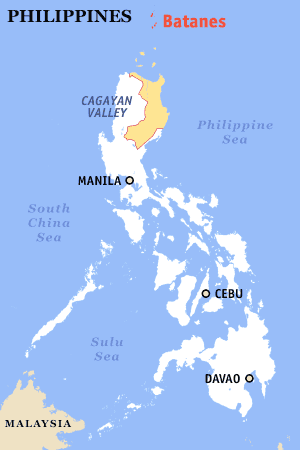Batanes
|
|
Batanes is the northernmost and the smallest, both in terms of population and land area, among the provinces of the Philippines. The province lies on a group of islands (called the Batanes Islands) in the Luzon Strait and is part of the Cagayan Valley region in Luzon. Its capital is Basco and is separated from the Babuyan Islands of Cagayan province by the Balintang Channel and from Taiwan by the Bashi Channel. The northenmost island is Mavudis Island. The other islands are Misanga, Ditarem, Siayan, Itbayat, Dinem, Batan, Sabtang, Ivuhos, and Diadekey. Only Itbayat, Batan, and Sabtang are inhabited. Batanes is about 190 kilometers south of Taiwan.
2000 census—16,467 (smallest)
Density—79 per km² (11th lowest)
Highly urbanized cities—0
Component cities—0
Municipalities—6
Barangays—29
Congressional districts—1

| Contents |
People and Culture
The indigenous people here are called Ivatan, who are linguistically, racially, physically, and culturally closer to the Taiwanese aborigines than to the other Filipinos. The main languages here are Ivatan, Itbayaten (which appears as a dialect of the preceding), and Ilocano, of which the former two are of Formosan origin. This accounts for their cultural dissimlarities with the Filipinos.
Economy
Geography
Political
Batanes is subdivided into 6 municipalities.
Municipalities
Physical
Batanes lies on a group of islands collectively called Batanes Islands and they are the northernmost islands of the Philippines. They are located between the Babuyan Islands (belonging to Cagayan Province) and Taiwan. The islands are sparsely populated and subject to frequent typhoons.
The three largest islands are Itbayat, Batan, and Sabtang. The northernmost is Mavudis Island.
History
It is generally recognized among anthropologists that the ancestors of today's Ivatans are descended from Austronesians who migrated to these islands 4000 years ago during the Neolithic period. The Pre-Hispanic Ivatans lived in fortified mountain areas called idjangs and drank sugar-cane wine, or palek. They also used gold as currency and produced a thriving agriculture-based industry. They were also people of the sea, being seafarers and boat-builders Between the 10th and 6th centuries, the Chinese came to the Batanes to trade with them. Some of the Chinese ceramic wares were found on Batan Island. On 1687, a crew of English freebooters, headed by a captain named William Dampier, came with a crew of Hollanders an named the islands in honor of their country's monarchs. Itbayat was named Orange Isle in honor of William of Orange, and Batan, Grafton Isle. Sabtang Isle was named Monmouth Isle after the Duke of Monmouth. Capt. Dampier stayed for less than three months, and did not claimed the islands for the British crown. However, since then Dominican friars have been trying to Catholicize the islanders, which failed. And finally, only in 1783 did the Spanish claimed Batanes as part of Spanish Asia (i.e., the Philippines), under the auspices of Governor-General Jose Basco y Vargas. However, the Ivatans remained on their idjangs, or mountain fortresses. In 1790, Governor Guerrero decreed that Ivatans were to leave their idjangs and to live in the lowlands, therefore giving them more people to tax. Basco and Ivana were the first towns. Mahatao was then administered by Basco, while Uyugan and Sabtang, by Ivana.Itbayat was not organized until the 1850's, its' coast being a ridge. Ivatans were then ordred to dresslike the other FIlipinos, and it didn't took them long to adopt. Soon, Ilocanos were being put in the islands, so as to control the native population there. Limestone technology used by the Spanish ere also being spread to the islands, so that their bridges became strong and fortified. Some of these bridges srill remain at both Ivana and Mahatao. By 1890, many Ivatans were in Manila, and became ilustrados, who thn brought with them home the revolutinary ideas of the Katipunan. These Ivatans, who were then very discontented with Spanish rule, killed the ruling General Fortea, and declared the end of Spanish rule. By 1899, the American regime was already steady. With no one to hamper progress, public schools suddenly boomed, and more Ivatan became more aware o their placein the Philippines. In 1920, the first wireless telegraph was installed here, followed by an airfield in 1930. Roads were constructed and during the American era, the Batanes High School was instituted. Durind the Second World War, the Japanese massacred many Ivatan men, and raped and molested Ivatan women. However, during the return of the Americans, Batanes regained its provincehood. Reference: Trek Batanes (Tan, Jose Maria Lorenzo, and Reyes, Elizabeth)
External links
- Northern Luzon cultures (http://www.seasite.niu.edu/Tagalog/Tagalog_Default_files/Philippine_Culture/Regional%20Cultures/northern_luzon_cultures.htm)
| Regions and Provinces of Luzon | |
| Ilocos Region: | Ilocos Norte | Ilocos Sur | La Union | Pangasinan |
| Cagayan Valley: | Batanes | Cagayan | Isabela | Nueva Vizcaya | Quirino |
| Central Luzon: | Aurora | Bataan | Bulacan | Nueva Ecija | Pampanga | Tarlac | Zambales |
| CALABARZON: | Batangas | Cavite | Laguna | Quezon | Rizal |
| MIMAROPA: | Marinduque | Occidental Mindoro | Oriental Mindoro | Palawan | Romblon |
| Bicol Region: | Albay | Camarines Norte | Camarines Sur | Catanduanes | Masbate | Sorsogon |
| Cordillera Adm. Region: | Abra | Apayao | Benguet | Ifugao | Kalinga | Mountain Province |
| Metro Manila: | No provinces |

